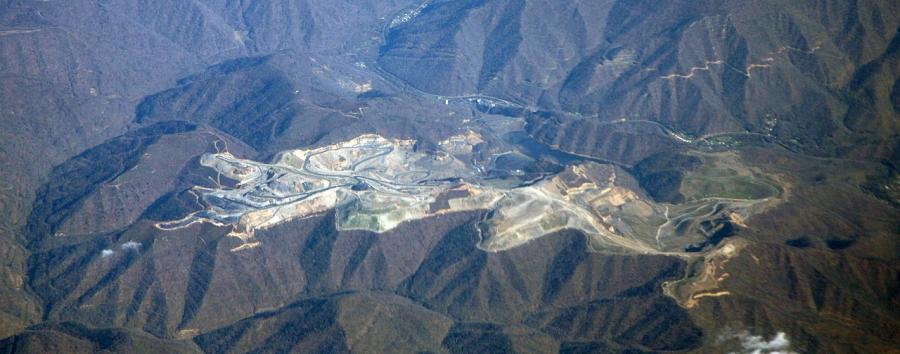
in Mingo County, WV. Image courtesy of the Ohio Valley Environmental Coalition.
A downloadable version of this lesson is available here:
As legacies of mining, oil and gas extraction, and chemical production create degraded ecosystems around the world, it becomes essential to develop a clear process for restoring these sites to functioning ecosystems with human social value and resilience amid climate change. Reclamation and restoration are complex and site-specific challenges, so the quality of the restoration design depends on enforceable standards based on principles of ecological integrity, long-term sustainability, benefits to society, and an awareness of past and future needs in species and climate conditions. As corporations become responsible for restoration projects, there has been a tendency to manipulate the public relations benefit by overselling or misdirecting the public about the value of the project: a form of greenwashing. In this lesson, learners will read the short article by Suding et al. (2015) to learn how multi-factor designs may improve restoration outcomes. Learners will then apply this analysis to prominent case studies of ecological restoration by major corporations involved in oil & gas extraction and chemical production. They will learn to scrutinize the claims surrounding restoration projects and analyze the degree of greenwashing inherent to corporate-led site reclamation.
- Learn details of multi-factor design principles to achieve the best ecological and social restoration outcomes.
- Enumerate greenwashing tactics that misrepresent the value of restoration ecology projects.
- Analyze a restoration case study in terms of its ecological design principles, its public-facing virtue signaling, and the degree of greenwashing inherent in these strategies.
Image courtesy of the Ohio Valley Environmental Coalition
Unaltered image by Doc Serles via Wikimedia Commons, Attribution 2.0.
View the image of the Twisted Gun Golf Course in Mingo County, West Viginia (top), versus the image of an active mountaintop mine (bottom). As a class, list a range of aesthetic and emotional reactions to these landscapes. What might the following stakeholders say about them: the mining company; a golfer; a local resident; an environmentalist? What range of emotional valences can legitimately result from contemplating restoration before-and-after? How does this ambiguity work in the favor of greenwashing tactics by the mining industry?
Ecological Restoration and Corporate Greenwashing (Two 75-minute classes)
As preparation for class, have learners read and take notes on the short article by Suding et al. (2015), paying special attention to the highlighted portions. Learners should also read and take notes on the article by de Freitas Netto et al. (2020), paying special attention to the highlighted portions as well as the list of greenwashing tactics on pages 8-10.
-
(10 min) Review the major principles of ecological restoration and types of greenwashing using the PowerPoint slides below.
Document -
(5 min.) Divide learners into working groups of 3-5 participants and assign them to the following case studies representing corporate-led ecological restoration or environmental preservation. Each link is a public-facing virtue site funded by the corporation itself, or a site developed by the Wildlife Habitat Council, a group founded by Anheuser Busch, BP, DuPont, Exxon and U.S. Steel to promote and manage the appearance of corporate environmental virtues.
BP Subsidiary Atlantic Richfield: Restoration of the Upper Clark Fork River Basin, MT
DuPont/Chemours: Washington Works Plant in Parkersburg, WV
National Mining Association: Mountaintop Mining Site Reclamation, WV
Crestwood Midstream: Pipeline Right-of-Way through the Fort Berthold Indian Reservation, ND
-
(20 min) Ask groups to read the “virtue” websites above while analyzing their adherence to the specific principles of ecological restoration outlined by the ecologists in the Suding et al. (2015) paper. These are: 1) Ecological Integrity, 2) Long-Term Sustainability, 3) Benefits and Engages Society, 4) Informed by Past and Future. For each principle, have the group estimate the degree of success in implementation as a score of 1–3: 1 is “minimal,” 2 is “moderate,” and 3 is “exemplary.” In general, how do they feel the corporations have done with respect to environmental transparency based on these websites?
-
(20 min.) Using the paired, case study-respective links below, have each group conduct further critical research into the corporation and its operations, the site history and environmental analyses, and social values preserved or erased by disturbance and restoration. These include government reports, scholarly articles, and popular environmental media, though participants may also find additional sources. Listed last is a blog post about greenwashing by the president of the Wildlife Habitat Council, which all groups may read.
Upper Clark Fork River Basin
Washington Works Plant
Mountaintop Mining Site Reclamation
Fort Berthold Indian Reservation
Wildlife Habitat Council: President’s Blog
-
(15 min.) For the rest of this class session, have groups update their initial analysis of the site’s adherence to four restoration principles based on further critical research.
-
Then, as homework before the next class session, ask each participant to identify the types of greenwashing they may see at work in their case study from the list provided in de Freitas Netto et al. (2020) (also listed below).
The hidden trade-off: Claims suggest that a product is ‘green’ based on a narrow set of attributes without attention to other important environmental issues (8).
No proof: Environmental claims that cannot be verified by supporting information or by a reliable third-party certification (8).
Vagueness: Claims that are so poorly defined or broad that their real meaning is likely to be misunderstood by the consumer (9).
Worshiping false labels: Products that mislead consumers into thinking that they have been through a legitimate green certification process, using a false suggestion or certification-like image (9).
Irrelevance: Environmental claims that may be truthful but are irrelevant for consumers seeking environmentally sustainable products (9).
Lesser of two evils: Claims that may be true within a product category, but distract the consumer from the greater environmental impacts of the category as a whole (9).
Fibbing: Environmental claims that are simply false (9).
False hopes: Claims that reinforce a false hope of sustainability in a product category that is not sustainable (9).
Fearmongering: Claims that fabricate consumer insecurity for not “buying in” to an organization practice, like hydraulic fracking (9).
Broken promises: Claims that promise to lift up poor, rural communities with riches from mineral rights and economic development, but when evidence shows the contrary, communities are left with irreversible environmental impacts (9).
Injustice: Claims that do not speak directly to communities most affected by extractive operations, but target a segment of the population that benefits from extraction and do not suffer its direct consequences (9).
Hazardous consequences: Claims that hide the reality of inequality and distract the public from the dangers of the risk (9).
Profits over people and the environment: Strategies that place private profit margins over local people and their environment—the greatest greenwashing problem of all (9).
Dirty business: Belonging to an inherently unsustainable business, but promoting sustainable practices or products that are not representative of the business or the society (9).
Ad bluster: Diverting attention from sustainability issues through the use of advertising. Exaggerating achievements or presenting alternative programs that are not related to the main sustainability concern (9).
Political spin: Influencing regulations or governments in order to obtain business benefits that negatively affect sustainability (10).
It’s the law, stupid!: Touting sustainability accomplishments or commitments that are already required by existing laws or regulations (10).
Fuzzy reporting: Taking advantage of sustainability reports and their one-way communication channel, to twist the truth or project a positive image in terms of corporate practices (10).
Executional greenwashing: Using nature evoking elements such as naturalistic colors and sounds. Website backgrounds represent natural landscapes or pictures of endangered animal species or renewable sources of energy are executional greenwashing (10).
-
(20 min.) In the next class session, reconvene groups and give them time to integrate each participants’ analysis of the types of greenwashing they suspect apply to their case study. They will then combine this information with their work from step 5 (from the previous session), in which they assessed the degree to which adherence to comprehensive restoration principles had taken place at their site. The groups will then prepare a brief (5-7 min) presentation on their findings.
-
(50 min.) Each group now has 5-7 minutes to present, and at least 3 minutes to field questions from peers and the instructor. A note-taker may be assigned to summarize each presentation and provide an overview of greenwashing across these four case studies, which can be accessed by learners in a course web space.
-
As homework, have each learner post the two to three most notable takeaways from this exercise. They might focus on how to better design and regulate restoration projects, highlight examples of true success stories, or detail how specific elements of greenwashing are damaging to efforts to achieve corporate accountability and restore degraded post-extraction landscapes.
-
BBC News: What Is Greenwashing?
This 12-minute video explores the phenomenon and gives specific examples, particularly of consumer product marketing strategies that are forms of greenwashing. The video includes interviews with consumer protection agency representatives.
BBC News. (2022, January 23). What Is Greenwashing? [Video]. YouTube. https://www.youtube.com/watch?v=0XGAMJsm6Tg
-
Visuality as Greenwashing: The Case of BP and Deepwater Horizon
The authors use a visual semiotic approach to explore how BP used the power of the visual after the 2010 Deepwater Horizon disaster. Through the careful construction of images on its corporate website, BP created a visual story that helped the company construct a “logic of representation” to occlude its problematic “logic of practice.” The BP case helps the public understand how companies deploy visual rhetoric to create the appearance of flattering realities. These greenwashing tactics divert attention from risky practices and aid post-disaster corporate image restoration.
Kassinis, G., & Panayiotou, A. (2018). Visuality as Greenwashing: The Case of BP and Deepwater Horizon. Organization & Environment, 31(1), 25-47. https://doi.org/10.1177/1086026616687014
-
The Drivers of Greenwashing
This article examines the external (institutional and market), organizational, and individual drivers of greenwashing and offers recommendations for managers, policymakers, and NGOs to decrease its prevalence.
Delmas, M. A., & Burbano, V. C. (2011). The Drivers of Greenwashing. California Management Review, 54(1), 64–87. https://doi.org/10.1525/cmr.2011.54.1.64

